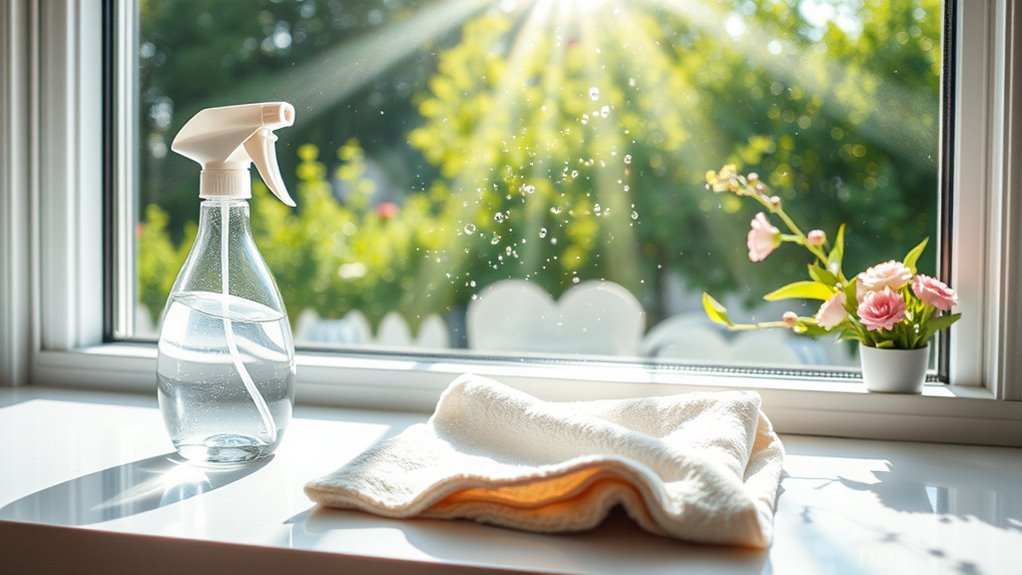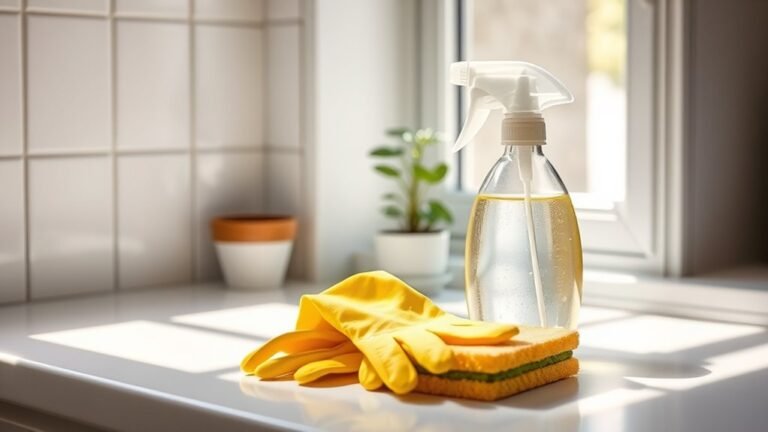Spring Cleaning Guide for Glass
For spring cleaning your glass, gather essentials like a microfiber cloth, squeegee, and spray bottle. Use a homemade vinegar-water solution for an eco-friendly, streak-free shine. Start by dusting, then spray evenly and wipe top to bottom. Dry edges to prevent residue. Be methodical: clean mirrors gently and polish tabletops with circular strokes. Avoid harsh chemicals to protect surfaces. Keeping these steps in mind guarantees sparkling glass, and there’s more helpful guidance to keep your glass pristine year-round.
Essential Tools for Cleaning Glass
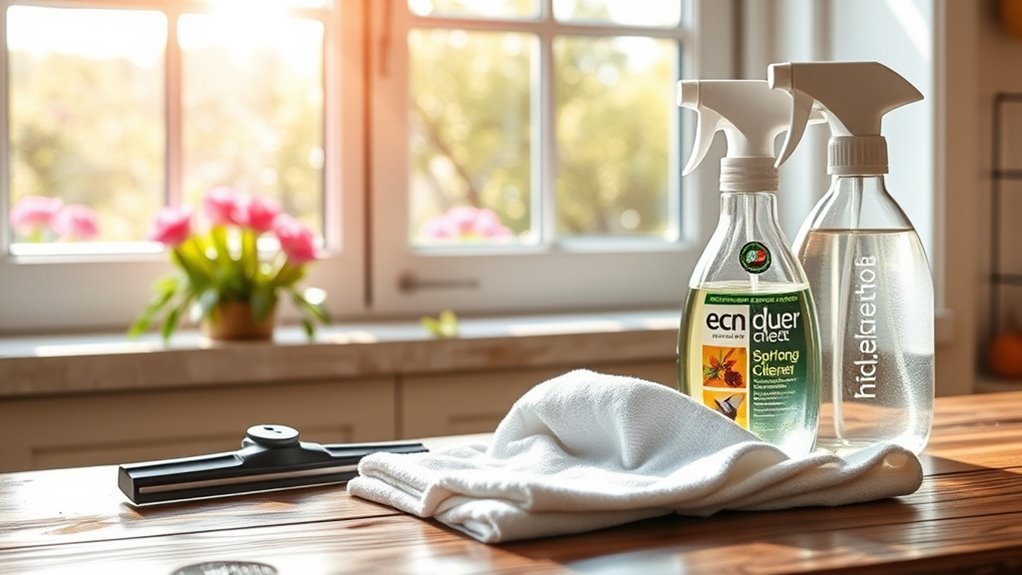
To effectively clean glass surfaces, you’ll need a few essential tools that guarantee streak-free results and ease of use. Start with a high-quality microfiber cloth; it traps dirt without scratching and absorbs moisture efficiently. A squeegee with a rubber blade is vital for removing liquid and preventing streaks on larger panes. You’ll also want a spray bottle to evenly distribute your cleaning solution, ensuring full coverage. Lint-free paper towels or cotton cloths serve well for spot cleaning and polishing. Finally, a soft-bristled brush helps dislodge stubborn debris from corners and edges. These glass cleaning tools form the core of your essential supplies, empowering you to maintain clear, sparkling surfaces with minimal effort and maximum freedom. Having the right equipment lets you work methodically and confidently. Ensure you start with a dust-free surface by removing loose debris before applying any cleaner for the best results.
Best Homemade Glass Cleaning Solutions
Having the right tools sets the stage for effective glass cleaning, but the cleaning solution you use plays an equally important role. You can easily make effective homemade solutions that free you from commercial chemicals. A vinegar solution is excellent for cutting grease and streaks, while a citrus cleaner adds a fresh scent and breaks down grime naturally. Here’s a simple guide:
| Solution Type | Ingredients | Usage Tips |
|---|---|---|
| Vinegar Solution | 1 part vinegar, 1 part water | Spray, wipe with microfiber cloth |
| Citrus Cleaner | Lemon juice, water, a dash of soap | Use on tough stains, rinse well |
| Alcohol Mix | Rubbing alcohol, water | Quick drying, ideal for mirrors |
Choose what fits your need and enjoy spotless, streak-free glass with freedom and ease. Using eco-friendly cleaning solutions helps protect both your glass fabric and the environment while maintaining effectiveness.
Step-by-Step Window Cleaning Process
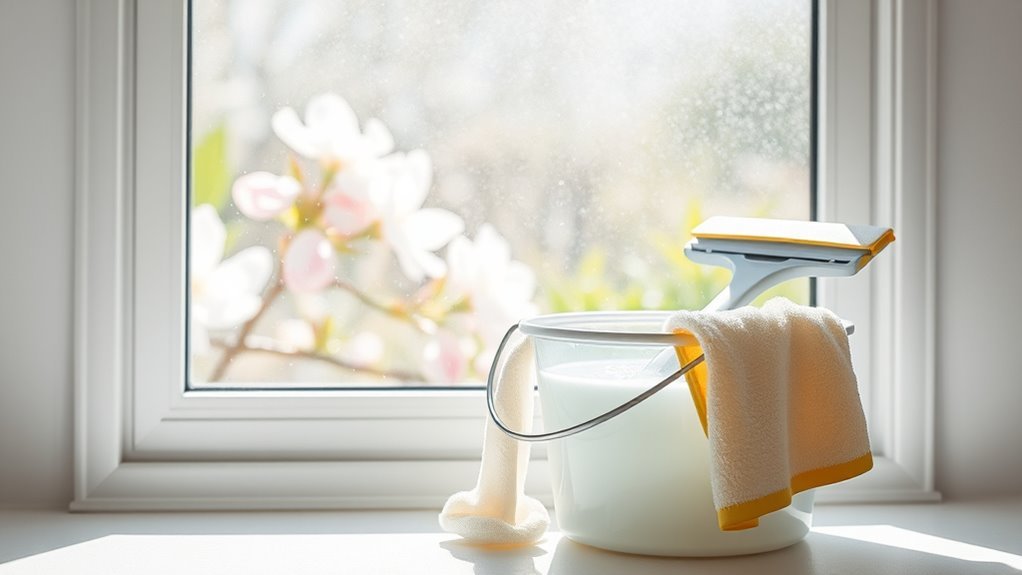
Cleaning your windows effectively involves a few straightforward steps that guarantee a streak-free finish. Mastering window cleaning techniques will free you from stubborn smudges and grime, especially during seasonal cleaning tips like spring.
- Remove dust and loose dirt with a soft brush or vacuum.
- Mix your homemade cleaning solution and apply it evenly with a spray bottle.
- Use a microfiber cloth or squeegee, wiping from top to bottom in smooth, overlapping strokes.
- Dry edges and corners with a clean, dry cloth to prevent residue buildup.
Following this methodical process guarantees clarity and lets you enjoy sunlight without obstruction. These seasonal cleaning tips help you maintain clear, spotless windows all year long, giving you freedom from constant upkeep. For best results, choose ideal temperatures between 50°F to 70°F to avoid streaks and ensure even drying.
How to Clean Mirrors Without Streaks
Windows aren’t the only glass surfaces that benefit from careful cleaning—mirrors require just as much attention to avoid streaks and smudges. For effective mirror maintenance, start by using a microfiber cloth to remove dust gently. Next, apply a streak-free glass cleaner or a vinegar-water solution in a fine mist. Avoid spraying directly onto the mirror; instead, spray the cloth to prevent excess moisture from seeping behind the glass. Wipe the surface in a consistent pattern—horizontal or vertical strokes work best—to guarantee thorough coverage and streak prevention. Finally, buff the mirror with a dry, clean microfiber cloth to eliminate any remaining moisture or residue. This methodical approach guarantees your mirrors stay crystal clear and streak-free, giving you the freedom to enjoy flawless reflections every day. Always begin by dusting before wiping to prevent smearing dirt across the glass surface.
Tips for Polishing Glass Tabletops
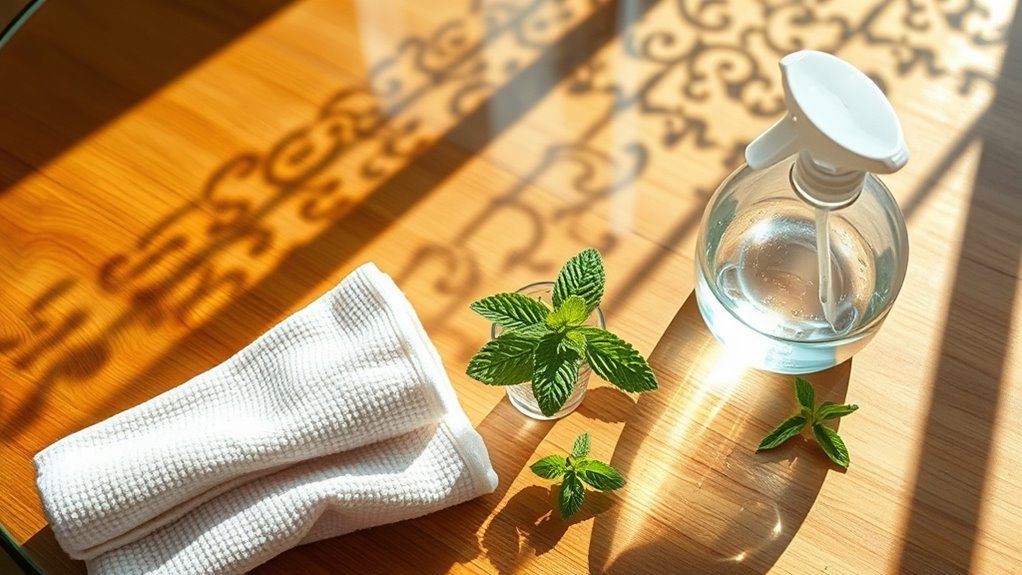
When polishing glass tabletops, selecting the right cleaner is essential to avoid damage and achieve a clear finish. You’ll want to use a non-abrasive, ammonia-free solution for the best results. Applying the cleaner with a microfiber cloth in circular motions helps prevent streaks and enhances shine. Always test a small area first to ensure the cleaner is safe for your glass surface.
Choosing the Right Cleaner
Although it might seem straightforward, selecting the right cleaner for your glass tabletop is crucial to achieving a streak-free, polished finish. You need a product that balances effectiveness with safety for both your glass and the environment. Consider these factors:
- Understand the chemical properties—avoid harsh acids or abrasives that can scratch or dull the surface.
- Look for eco-friendly options that use natural ingredients; they clean well without harmful residues.
- Choose a cleaner with quick evaporation to minimize streaking and residue buildup.
- Test on a small area to verify compatibility and avoid damage.
Techniques for Streak-Free Shine
Three essential techniques will help you achieve a streak-free shine on your glass tabletop. First, use a microfiber cloth to avoid streak prevention by capturing dust and dirt without smearing. Second, apply cleaner in small sections to maintain control and enhance shine enhancement. Third, polish with circular motions, finishing with vertical strokes for a flawless finish.
| Technique | Benefit | Feeling |
|---|---|---|
| Microfiber Cloth | Captures dust | Confident |
| Small Cleaner Areas | Controlled cleaning | Empowered |
| Circular Polishing | Even shine | Satisfied |
| Vertical Finish | Streak-free shine | Free |
Following these steps gives you freedom from streaks, revealing the true brilliance of your glass surface.
Removing Tough Stains and Spots From Glass
When tough stains and spots appear on your glass, you’ll need targeted techniques to remove them effectively without causing damage. Using the right cleaning solutions and tools can make a significant difference in restoring clarity. Additionally, adopting preventative measures will help keep your glass looking spotless longer. For the best results, consider using natural cleaning solutions like vinegar or lemon juice to achieve a streak-free shine safely.
Effective Stain Removal Techniques
Tackling tough stains on glass requires a few targeted techniques that go beyond regular cleaning. Different stain types demand specific removal methods to restore clarity without damage. Here’s how you can effectively remove stubborn spots:
- Mineral Deposits: Use a mixture of white vinegar and water to dissolve hard water stains. Apply, let sit for 5 minutes, then wipe clean.
- Grease and Fingerprints: A solution of dish soap and warm water breaks down oily residues efficiently.
- Paint or Adhesive Residue: Gently scrape with a plastic razor blade after softening with rubbing alcohol.
- Mildew or Mold: Clean with a diluted bleach solution, ensuring proper ventilation.
Preventing Future Glass Spots
After removing stubborn stains, the next step is to focus on preventing new spots from forming on your glass surfaces. Implementing preventive measures and committing to regular maintenance will extend the clarity and shine of your glass. Here’s a streamlined approach to help you maintain spotless glass:
| Preventive Measure | Suggested Actions |
|---|---|
| Regular Cleaning | Use mild detergent and microfiber cloth weekly |
| Protective Coatings | Apply water-repellent sprays monthly |
| Immediate Spot Removal | Wipe spills promptly to avoid buildup |
| Proper Ventilation | Reduce humidity to prevent condensation |
| Routine Inspection | Check glass surfaces for early signs of staining |
Cleaning Decorative Glass Items Safely
Although decorative glass items add elegance to your space, cleaning them requires special care to avoid damage. To master decorative glass care with safe cleaning techniques, follow these steps:
Decorative glass enhances your space but demands gentle cleaning to maintain its beauty and prevent damage.
- Use a soft microfiber cloth to gently remove dust without scratching.
- Prepare a mild cleaning solution with warm water and a few drops of dish soap.
- Avoid harsh chemicals or abrasive scrubbers that can erode delicate surfaces.
- Rinse thoroughly with clean water and dry immediately to prevent water spots.
Preventing Smudges and Fingerprints on Glass
Since glass surfaces easily show smudges and fingerprints, preventing these marks is essential for maintaining a clean appearance. To minimize daily buildup, consider applying fingerprint resistant coatings, which create a protective layer that repels oils and dirt. These coatings reduce the frequency of cleaning, giving you more freedom from constant upkeep. Additionally, anti smudge sprays offer a practical solution—simply spray and wipe to form a barrier that inhibits fingerprint adherence. When applying either product, follow manufacturer instructions carefully to guarantee uniform coverage and lasting effect. Incorporate these preventive measures on high-touch glass areas like doors, windows, and screens. By proactively protecting your glass, you’ll keep surfaces clear and reduce cleaning time, making it easier to enjoy bright, spotless glass throughout your living space. Using a microfiber cloth during cleaning will also help prevent additional smudges and maintain the glass’s clarity.
Maintaining Sparkling Glass Throughout the Year
Protecting your glass surfaces from smudges and fingerprints is just one step toward keeping them pristine. To maintain sparkling glass throughout the year, adopt a routine maintenance plan combined with seasonal glass care. Follow these four key steps:
Keeping glass pristine requires regular care paired with a consistent maintenance routine throughout the year.
- Clean regularly using a microfiber cloth and a vinegar-water solution to avoid streaks.
- Inspect for damage or wear during seasonal checks and address issues promptly.
- Avoid abrasive cleaners or tools that can scratch glass surfaces.
- Apply a protective coating or glass sealant during your spring cleaning to reduce dirt buildup.
Additionally, ensure good ventilation around your windows to help prevent moisture buildup and maintain the clarity of your glass surfaces. This promotes a healthier environment and protects against potential damage from dampness, as detailed in preventing damage and mold growth.
Frequently Asked Questions
Can I Use Vinegar on Antique Glass Without Damaging It?
When it comes to antique restoration, you want to be extra gentle. Vinegar, while a popular cleaning solution, can sometimes be a bit too spirited for antique glass, potentially causing damage over time. You’d be better off opting for a mild, pH-neutral cleaner designed specifically for delicate surfaces. Always test a small, hidden area first, and avoid harsh scrubbing. This careful approach preserves your glass’s charm while keeping your freedom to enjoy it fully.
How Do I Safely Clean Glass in Picture Frames?
To safely clean glass in picture frames, start by choosing gentle cleaning tools like a microfiber cloth and mild glass cleaner. Avoid spraying liquid directly on the glass to protect frame preservation; instead, lightly dampen the cloth. Carefully wipe the glass surface, steering clear of frame edges to prevent moisture damage. This method keeps your frames looking fresh while preserving their integrity and your freedom to enjoy your artwork worry-free.
Are There Special Techniques for Cleaning Glass on Electronic Screens?
When cleaning electronic screens, you’ll want to avoid harsh chemicals and abrasive materials. Use only microfiber cloths to gently wipe away dust and fingerprints without scratching. If your device has a screen protector, clean it carefully to prevent damage or lifting. Lightly dampen the cloth with distilled water or a screen-safe cleaner—never spray directly on the screen. These methods keep your device clear and protected while giving you the freedom to clean confidently.
What’S the Best Way to Clean Glass Shower Doors With Hard Water Buildup?
If hard water on your shower doors looks like it’s turned them into frosted glass forever, don’t panic. You can reclaim that sparkle by mixing equal parts white vinegar and water in a spray bottle. Spray generously, let it sit for 10-15 minutes to dissolve the mineral buildup, then scrub gently with a non-abrasive sponge. Rinse and squeegee dry. This method is simple, effective, and frees your doors from stubborn hard water chains.
Can Glass Cleaners Harm Window Seals or Caulking?
Yes, some glass cleaner compositions can harm window seals or caulking if they contain harsh chemicals like ammonia or strong solvents. These ingredients may degrade rubber or silicone over time, reducing window seal longevity. To protect your seals, choose mild, non-abrasive glass cleaners or those labeled safe for seals. Always test a small area first and avoid letting cleaners sit too long on caulking to maintain its integrity and your window’s performance.
